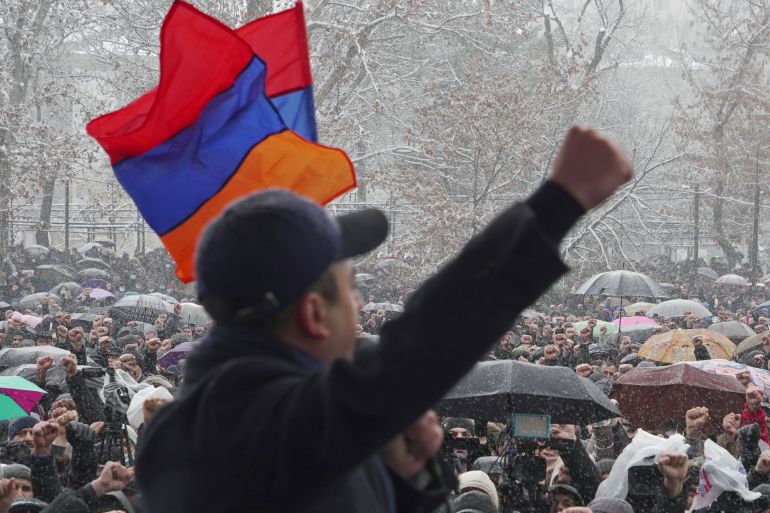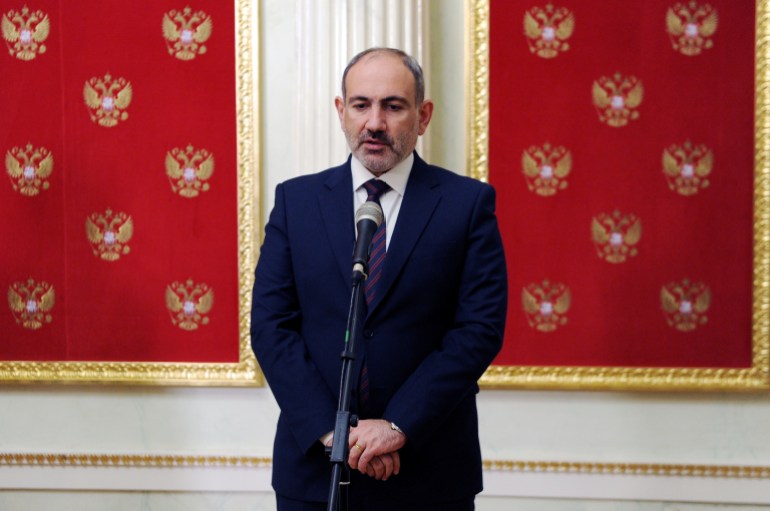Armenia protests: PM Pashinyan faces fresh calls to quit
Nikol Pashinyan is facing renewed calls for his resignation as his opponents condemn his handling of the recent conflict with Azerbaijan.

Months-long calls for Armenian Prime Minister Nikol Pashinyan to resign escalated again on Tuesday, as thousands of protesters staged the third demonstration in a week demanding he quit over his handling of the Nagorno-Karabakh conflict with Azerbaijan.
Police cordons were deployed to guard government buildings near Republic Square in the capital Yerevan, with officers accompanying Pashinyan when he walked from one building to another as demonstrators shouted “traitor!”.
Keep reading
list of 4 itemsNagorno-Karabakh: Russia’s Putin hosts Azeri, Armenian leaders
Conspiracy theories in Armenia have put NGO work in danger
Azerbaijani prisoner released by Armenia alleges torture
A day earlier, protesters marched to Yerevan’s France Square and blocked several adjacent streets, temporarily paralysing traffic in the area.
The demonstrations follow protests last November, which grew after Pashinyan signed a Russian-brokered peace deal following six weeks of conflict that claimed thousands of lives and saw swathes of territory in and around Nagorno-Karabakh ceded to Azerbaijan.
The mountainous region is internationally recognised as Azerbaijan’s land, but has been under the control of ethnic Armenian forces and self-appointed Armenian officials, backed by Armenia, since an earlier war between the rivals concluded in a ceasefire in 1994.
The protests had gone dormant for a spell in the depth of Armenia’s winter, but first resumed on Saturday, when thousands of demonstrators took to Yerevan’s streets.
“Actions of [civil] disobedience need to continue for a long time, the city should be paralysed every once in a while,” said Ayk Mamidzhanyan of the Republican Party of Armenia.

Despite the pressure, Pashinyan has refused to step down. He has defended the peace deal as a painful but necessary move that prevented Azerbaijan from overrunning the Nagorno-Karabakh region.
In an apparent concession to the protesters, Pashinyan in December raised the prospect of early parliamentary elections this year. However, Pashinyan’s My Step parliamentary alliance appeared to backtrack on that proposal earlier this month.
Armenia eyes expanded Russian military presence
Monday’s protests came as Armenian Defence Minister Vagharshak Harutyunyan said the country would welcome the expansion of a Russian military base on its territory and the redeployment of some Russian forces closer to its border with Azerbaijan, following last year’s conflict.
Under the peace deal, which was celebrated in Azerbaijan as a big triumph, Russia has deployed about 2,000 peacekeepers to Nagorno-Karabakh for at least five years.
Russia also has a fully-fledged military base manned by some 3,000 troops in the Armenian city of Gyumri, near the Turkish border, under a formal defence pact with Armenia.
“The question of expanding and bolstering the Russian military base on the territory of Armenia has always been on the agenda,” Harutyunyan told Russia’s RIA news agency. “The Armenian side has always been interested in this.”
Harutyunyan did not, however, say whether there were any concrete plans for a potential expansion.
Harutyunyan also dismissed calls from opposition politicians for the creation of a second Russian base in Armenia’s southern Syunik region, wedged between Azerbaijan and the Azeri exclave of Nakhchivan.
He said he saw no need for Russia to formally open a second military base, but added the two countries were considering deploying a military unit from the existing base to eastern Armenia, near the border with Azerbaijan.
Harutyunyan did not disclose the purpose of the potential redeployment nor its exact location.